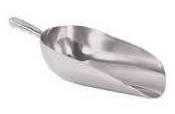Note: Before you start mixing the concrete ingredients make sure you have collected all of your finishing tools and have placed them near the concrete countertop mold. This includes your trowels, screeds, rubber gloves, concrete vibrator and safety equipment.
While many books may suggest that you can mix your concrete in an assortment of containers including buckets and wheelbarrows, these suggestions are as close to ridiculous as one can get. If you are serious about making a concrete countertop you have to buy or rent a concrete mixer. There are enough external complexities in making a good batch of concrete to take care of without adding pour mixing!
Note: If you rent a concrete mixer ensure that the mixing bucket is perfectly clean and that there are no left over pieces of concrete residue from the last person who rented it in order to pour some concrete for a driveway or patio.
Step 1
Make sure that the concrete mixer is in a location that makes it as easy as possible to load and empty the drum without tripping over obstacles. Concrete mixers are designed to work best if they are level to the ground that they are sitting on.
Turn the mixer on.
Step 2
Place the aggregate in the concrete mixer.
Step 3
Place the sand in the concrete mixer.
Step 4
Allow the sand and aggregate to mix together for about 5 minutes.
Step 5
Add the portland cement to the mixer a little at a time allowing each scoop of cement to thoroughly blend with the sand and aggregate.
Note: A flour scoop, as shown in Figure D, is a good tool for adding the portland cement to the concrete mixer.

Figure D - Flour scoop
Watch for clumping. If any of the materials were wet it is not uncommon to get clumping. If this occurs, stop the mixer and break up the clumps with your hands.
Step 6
Allow all of the sand, aggregate and portland cement to mix together for about 3 minutes.
Step 7
Mix the water reducer and the pigment into one of the batches of water. Remember in the preparation of the materials we measured out two batches of water.
Step 8
Add small quantities of the water, pigment and water reducer mixture to the dry ingredients, distributing it as evenly as possible throughout the dry ingredients. Do not dump all of the water and water reducer into the dry ingredients all at once as this will cause some of the mixture to absorb more than its share of the water.
Note: Always wear the mask, gloves, and goggles or face mask when handling the pigments.
Step 9
Break up the polypropylene fibers in your hands and sprinkle them over the entire surface of the concrete as it is being mixed. Continue to add the fibers until all of them have been equally dispersed throughout the concrete mixture.
Step 10
Watch the mixture as it is being blended and slowly add additional water from the second set of pails as needed. You should not need all of the water from the second set of pails. How much of the water you need from the second set of pails is relative to the moisture content of the sand and aggregates before they were placed in the concrete mixer and the temperature and humidity.
Note: It is important to remember that you can always add a little more water, but if you put in too much water, you have basically ruined that batch of concrete and should start over!
Step 11
Allow the concrete mixer to continue to run for approximately 5 minutes, then turn it off and allow the concrete to rest for about 10 minutes. Turn the mixer back on and run it for an additional 10 minutes. If the concrete has stiffened up you can add a little more water, in small amounts until it returns to the proper consistency.
Step 12
When you think you have the correct amount of water in the mix and it is totally blended do the slump test to ensure that you have in fact made a good batch of concrete. You can throw the slump test concrete back into the mixer.
Step 13
Once the concrete is mixed it is ready to be moved to the mold. You can use a wheelbarrow or some more 5 gallon pails.
Continued - How to fill the countertop mold with concrete
How to Make Concrete Countertops - Index
